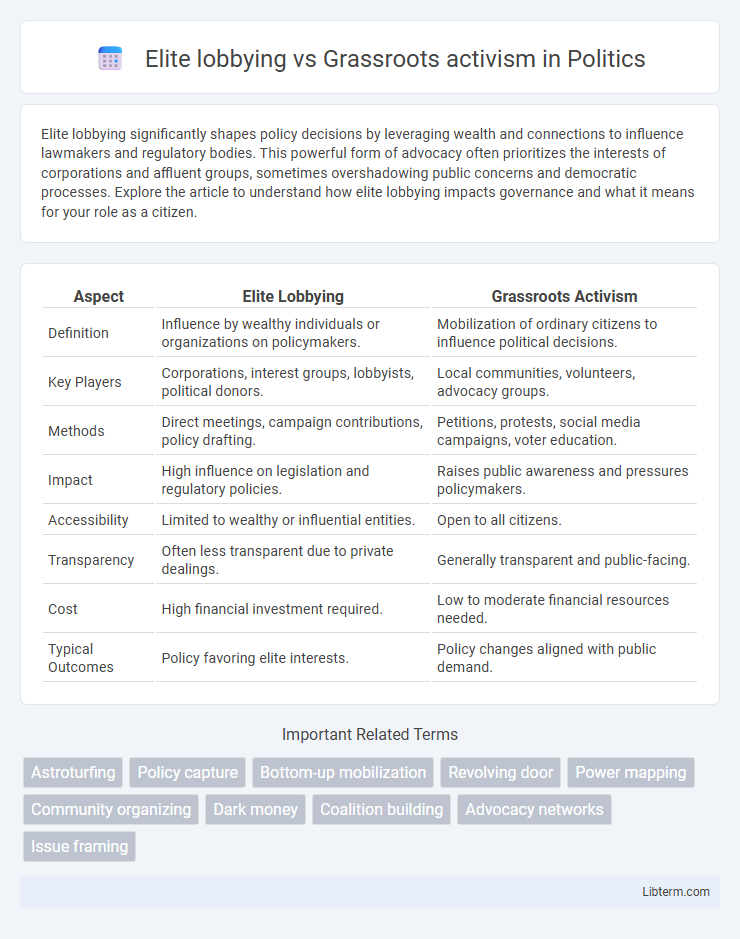Elite lobbying significantly shapes policy decisions by leveraging wealth and connections to influence lawmakers and regulatory bodies. This powerful form of advocacy often prioritizes the interests of corporations and affluent groups, sometimes overshadowing public concerns and democratic processes. Explore the article to understand how elite lobbying impacts governance and what it means for your role as a citizen.
Table of Comparison
| Aspect | Elite Lobbying | Grassroots Activism |
|---|---|---|
| Definition | Influence by wealthy individuals or organizations on policymakers. | Mobilization of ordinary citizens to influence political decisions. |
| Key Players | Corporations, interest groups, lobbyists, political donors. | Local communities, volunteers, advocacy groups. |
| Methods | Direct meetings, campaign contributions, policy drafting. | Petitions, protests, social media campaigns, voter education. |
| Impact | High influence on legislation and regulatory policies. | Raises public awareness and pressures policymakers. |
| Accessibility | Limited to wealthy or influential entities. | Open to all citizens. |
| Transparency | Often less transparent due to private dealings. | Generally transparent and public-facing. |
| Cost | High financial investment required. | Low to moderate financial resources needed. |
| Typical Outcomes | Policy favoring elite interests. | Policy changes aligned with public demand. |
Understanding Elite Lobbying and Grassroots Activism
Elite lobbying involves professional advocates or interest groups using direct access to policymakers and financial resources to influence legislation and regulation. Grassroots activism relies on mobilizing ordinary citizens to create public pressure and demonstrate broad-based community support for specific causes. Both strategies shape policy outcomes, with elite lobbying emphasizing insider connections and grassroots activism leveraging collective citizen engagement.
Key Differences Between Elite Lobbying and Grassroots Activism
Elite lobbying involves influential individuals or organizations using direct access to policymakers and substantial financial resources to shape legislation and public policy. Grassroots activism mobilizes ordinary citizens to participate in collective actions such as protests, petitions, and community organizing, aiming to create bottom-up pressure on political leaders. The key differences lie in the source of influence--top-down versus bottom-up--and the methods used, with elite lobbying relying on insider connections and lobbying firms, while grassroots activism depends on public engagement and mass mobilization.
Historical Context: Evolution of Advocacy Strategies
Elite lobbying originated in the early 20th century as corporations and influential individuals sought to directly influence legislators through formal channels and financial contributions. Grassroots activism gained momentum during the 1960s civil rights and anti-war movements, emphasizing mass public participation and decentralized organizing to pressure policymakers. Over time, advocacy strategies evolved with elite lobbying focusing on expert-driven policy shaping, while grassroots activism leveraged social media and community mobilization to amplify public demands.
Power Dynamics: Who Holds the Influence?
Elite lobbying wields significant influence through direct access to policymakers, substantial financial resources, and professional expertise, allowing concentrated power to shape legislation and regulatory decisions. Grassroots activism gains influence by mobilizing public opinion, fostering community engagement, and leveraging social media to amplify voices and pressure decision-makers from the bottom up. The power dynamics reveal a tension between centralized, resource-driven elite lobbying and decentralized, people-driven grassroots activism, each shaping policy outcomes through contrasting mechanisms of influence.
Funding Sources and Resource Allocation
Elite lobbying typically relies on substantial funding from corporate entities, wealthy individuals, and special interest groups, enabling access to high-powered lawmakers and extensive research capabilities. Grassroots activism depends heavily on small donations, volunteer efforts, and limited financial resources, focusing on mobilizing local communities and public engagement to influence policy. Resource allocation in elite lobbying prioritizes strategic lobbying, campaign contributions, and policy advocacy, while grassroots movements emphasize outreach, education, and grassroots mobilization.
Tactics and Methods: Lobbying vs. Activism
Elite lobbying employs targeted strategies such as direct engagement with legislators, policy drafting, and campaign financing to influence decision-making at high levels. Grassroots activism relies on mass mobilization, public demonstrations, digital advocacy, and petition drives to pressure policymakers through public opinion. Lobbyists prioritize professional relationships and insider access, whereas activists emphasize community organizing and social media outreach to amplify collective voices.
Case Studies: Notable Campaigns and Outcomes
Elite lobbying in cases like the Tobacco Institute's campaigns influenced policy through direct access to lawmakers, resulting in delayed regulations on tobacco products. Grassroots activism, exemplified by the Civil Rights Movement, mobilized widespread public support to achieve significant legal and societal changes, such as the Civil Rights Act of 1964. Both strategies demonstrate distinct pathways: elite lobbying leverages concentrated power and resources, while grassroots activism harnesses broad-based community engagement to shape policy outcomes.
Impact on Policy and Legislation
Elite lobbying wields significant influence on policy and legislation through direct access to policymakers, substantial financial resources, and specialized expertise, enabling precise advocacy tailored to lawmakers' priorities. Grassroots activism impacts legislation by mobilizing public opinion, generating widespread awareness, and creating pressure through collective action, which can shift political agendas and foster democratic participation. The interplay between elite lobbying and grassroots activism often shapes legislative outcomes, balancing institutional power with popular demands.
Media Representation and Public Perception
Elite lobbying commands significant media coverage due to its access to high-profile policymakers and substantial financial resources, often framing policy debates through expert-driven narratives. Grassroots activism relies on localized media and social platforms to amplify voices, shaping public perception by emphasizing community-driven urgency and moral appeal. Media representation of elite lobbying tends to appear more authoritative, while grassroots efforts are portrayed as authentic and participatory, influencing public trust and engagement differently.
Future Trends: The Changing Landscape of Advocacy
Elite lobbying is expected to leverage advanced data analytics and artificial intelligence to refine influence strategies, increasing precision in policy targeting. Grassroots activism is gaining momentum through digital platforms, enabling decentralized mobilization and real-time engagement with a broader demographic. Future advocacy landscapes will likely blend elite sophistication with grassroots authenticity, creating hybrid models that maximize political impact and public resonance.
Elite lobbying Infographic

 libterm.com
libterm.com